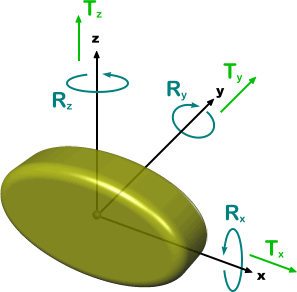6-DOF Rigid Body Motion
Simcenter STAR-CCM+ allows you to model the motion of a rigid body in response to applied forces and moments. In a rigid body, the relative distance between internal points does not change. Therefore, it is sufficient to solve the equations of motion for the center of mass of the body.
- A continuum body is a rigid body that is coupled with a fluid boundary (which represents the surface of the rigid body).
Simcenter STAR-CCM+ calculates the motion of the body in response to the fluid forces and moments at the coupled boundary. Additional user-defined forces and moments can be included in the calculation. In
Simcenter STAR-CCM+, the coupling between a fluid and a rigid body is referred to as Dynamic Fluid-Body Interaction (DFBI).
The effect of the motion of the rigid body on the fluid is accounted for by morphing the fluid boundary (DFBI Morphing), or by moving the entire fluid mesh rigidly (DFBI Rotation and Translation and DFBI Embedded Rotation). For more information, see Mesh Motion.
- A mechanical body is a rigid body that is not coupled with a fluid mesh. Simcenter STAR-CCM+ calculates the motion of the body in response to user-defined forces and moments. This type of rigid body is typically used to model parts of a body for which the coupling with the fluid can be neglected.
Degrees of Freedom
The motion of a 3D rigid body that is free to rotate and translate in all directions has 6 degrees of freedom:

where:
- Tx, Ty, and Tz are the translations in the x, y, and z directions, respectively.
- Rx, Ry, and Rz are the rotations about the x, y, and z axes, respectively.
Unconstrained 3D rigid bodies are often referred to as 6-DOF (6 degrees of freedom) bodies. The number of degrees of freedom reduces to three for unconstrained 2D rigid bodies, which can only translate along the two axes that define the 2D plane, and rotate around the axis perpendicular to the plane.
The motion of a rigid body can also be constrained by preventing the translation or rotation in certain directions. Constraints reduce the number of degrees of freedom.
The following sections discuss the equations of free and constrained motions for the general 3D case.